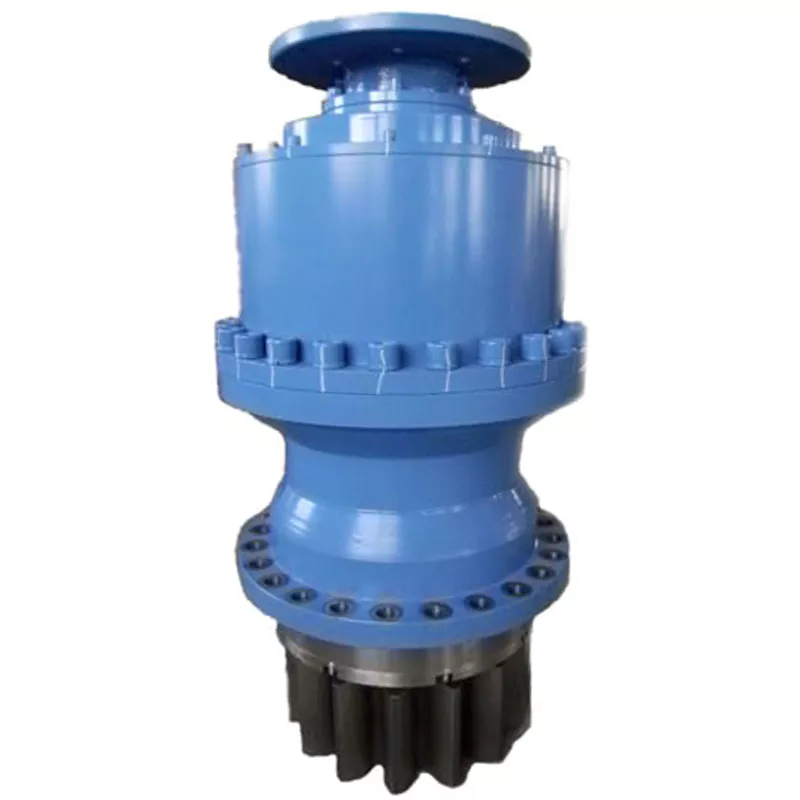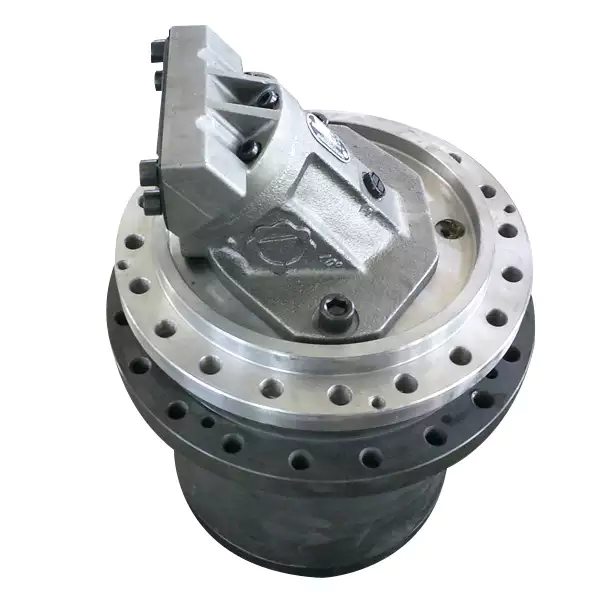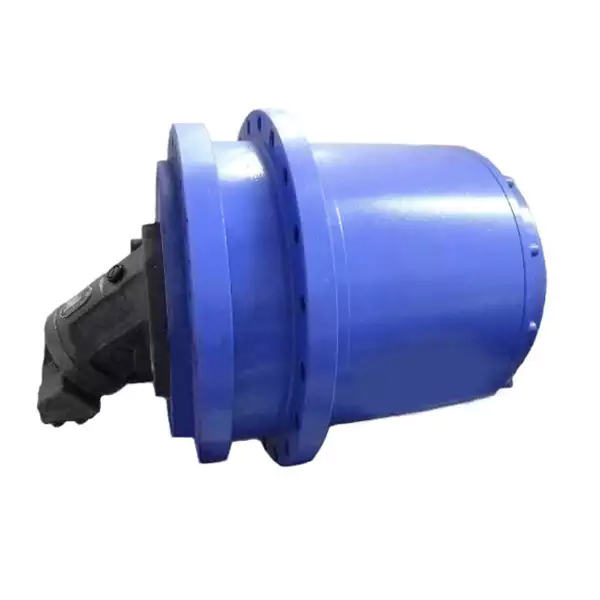Product Description
Product Description
Model: GFR Series
Ratio: 5-28
Output Torque: N.m
HYDRAULIC GFT is an ideal driving component for wheel or track driving vehicles, and other moving equipment and widely applied in excavator, speading machine, drill machine, mobile crusher, engineering machiner, mining, tunnel machiner, agricultural machiner,etc. It is an ideal replacement of CZPT products.
400 series hydraulic transmission can endure the large outside radial and axial forces. It features for high torque, high starting efficiency, low speed stability and low noisy operating. Thus it is widely used in construction machinery, railway, ship, petroleum, mining and metallurgy equipments.
Features:
1. One-or two-stage planetary gearboxes, smooth operation and reasonable structure.
2. Small volume, compact structure and high transmission efficiency.
3. Radial piston hydraulic motor with long life operating.
4. Mounting dimension is available on request.
5. Brake, balance valve, shuttle valve and the distributor which can integrate all kinds of function valve are also available on request.
Product Specification
| Model | Total displacement (ml/r) |
Rated torque | Speed (rpm) |
Total Efficiency | Hydraulic Motor | Planetary Gearbox |
Brake |
| 20MPa | |||||||
| GFR2.5-850 | 830 | 2350 | 0-100 | 0.88-0.9 | GM05-170 | C2.5-5 | Z2.5 |
| GFR2.5-950 | 955 | 2706 | 0-100 | 0.88-0.9 | GM05-200 | C2.5-5 | Z2.5 |
| GFR2.5-1050 | 1050.5 | 2976 | 0-100 | 0.88-0.9 | GM05-200 | C2.5-5.5 | Z2.5 |
| GFR3-1450 | 1450 | 4571 | 0-90 | 0.88-0.9 | GM1-300 | C3-5 | Z3 |
| GFT3-1700 | 1735 | 4823 | 0-90 | 0.88-0.9 | GM2-350 | C3-5 | Z3 |
| GFR3-1900 | 1908 | 5306 | 0-80 | 0.88-0.9 | GM2-350 | C3-5.5 | Z3 |
| GFR3-2300 | 2338 | 6492 | 0-75 | 0.88-0.9 | GM2-420 | C3-5.5 | Z3 |
| GFR4-3000 | 2975 | 8398 | 0-80 | 0.9-0.91 | GM3-600 | C4-5 | Z4 |
| GFR4-4000 | 3960 | 11222 | 0-80 | 0.9-0.91 | GM3-800 | C4-5 | Z4 |
| GFR4-4400 | 4356 | 12344 | 0-70 | 0.9-0.91 | GM3-800 | C4-5.5 | Z4 |
| GFR5-5700 | 5714 | 16056 | 0-65 | 0.9-0.91 | GM5-1000 | C5-5.5 | Z5 |
| GFR5-6700 | 6700 | 18915 | 0-70 | 0.9-0.91 | GM5-1300 | C5-5 | Z5 |
| GFR5-8150 | 8170 | 22987 | 0-70 | 0.9-0.91 | GM5-1600 | C5-5 | Z5 |
| GFR5-9000 | 9080 | 25612 | 0-70 | 0.9-0.91 | GM5-1800 | C5-5 | Z5 |
| GFR5-11000 | 11039 | 31159 | 0-50 | 0.9-0.91 | GM5-2000 | C5-5.5 | Z5 |
| GFR6-12500 | 12565 | 35476 | 0-40 | 0.9-0.91 | GM6-2500 | C6-5 | Z6 |
| GFR6-15200 | 15205 | 42987 | 0-40 | 0.9-0.91 | GM6-3000 | C6-5 | Z6 |
| GFR6-16500 | 16725 | 47286 | 0-30 | 0.9-0.91 | GM6-3000 | C6-5.5 | Z6 |
| GFR6-20000 | 19860 | 57141 | 0-30 | 0.9-0.91 | GM6-3600 | C6-5.5 | Z6 |
| GFR7-21500 | 21490 | 61902 | 0-35 | 0.9-0.91 | GM7-4300 | C7-5 | Z7 |
| GFR7-23650 | 23639 | 68092 | 0-30 | 0.9-0.91 | GM7-4300 | C7-5.5 | Z7 |
| GFR9-33000 | 33180 | 92928 | 0-15 | 0.9-0.91 | GM9-6600 | C9-5.0 | Z9 |
| GFR9-38500 | 38480 | 107800 | 0-15 | 0.9-0.91 | GM9-7700 | C9-5.0 | Z9 |
| GFR9-48400 | 48598 | / | 0-15 | 0.9-0.91 | GM9-8800 | C9-5.5 | Z9 |
| GFR9-66000 | 66143 | / | 0-15 | 0.9-0.91 | GM9-12000 | C9-5.5 | Z9 |
/* January 22, 2571 19:08:37 */!function(){function s(e,r){var a,o={};try{e&&e.split(“,”).forEach(function(e,t){e&&(a=e.match(/(.*?):(.*)$/))&&1
| Application: | Machinery, Agricultural Machinery |
|---|---|
| Function: | Speed Changing, Speed Reduction |
| Layout: | Three-Ring |
| Hardness: | Hardened Tooth Surface |
| Installation: | Torque Arm Type |
| Step: | Three-Step |
| Customization: |
Available
| Customized Request |
|---|

Concept of Coaxial and Parallel Shaft Arrangements in Planetary Gearboxes
In planetary gearboxes, the arrangement of shafts plays a crucial role in determining the gearbox’s overall structure and functionality. The two common shaft arrangements are coaxial and parallel configurations:
Coaxial Shaft Arrangement: In a coaxial arrangement, the input shaft and output shaft are positioned along the same axis, resulting in a compact and streamlined design. The planetary gears and other components are aligned concentrically around the central axis, allowing for efficient power transmission and reduced space requirements. Coaxial planetary gearboxes are commonly used in applications where space is limited, and a compact form factor is essential. They are often employed in robotics, automotive systems, and aerospace mechanisms.
Parallel Shaft Arrangement: In a parallel arrangement, the input and output shafts are positioned parallel to each other but on different axes. The planetary gears are aligned in a way that allows the power to be transmitted from the input shaft to the output shaft via a combination of meshing gears. This arrangement allows for a larger gear diameter and higher torque transmission capabilities. Parallel planetary gearboxes are often used in applications requiring high torque and heavy-duty performance, such as industrial machinery, construction equipment, and material handling systems.
The choice between coaxial and parallel shaft arrangements depends on the specific requirements of the application. Coaxial configurations are favored for compactness and efficient power transmission, while parallel configurations excel in handling higher torque and heavy loads. Both arrangements offer distinct advantages and are chosen based on factors like available space, torque demands, load characteristics, and overall system design.

Maintenance Practices to Extend the Lifespan of Planetary Gearboxes
Proper maintenance is essential for ensuring the longevity and optimal performance of planetary gearboxes. Here are specific maintenance practices that can help extend the lifespan of planetary gearboxes:
1. Regular Inspections: Implement a schedule for routine visual inspections of the gearbox. Look for signs of wear, damage, oil leaks, and any abnormal conditions. Early detection of issues can prevent more significant problems.
2. Lubrication: Adequate lubrication is crucial for reducing friction and wear between gearbox components. Follow the manufacturer’s recommendations for lubricant type, viscosity, and change intervals. Ensure that the gearbox is properly lubricated to prevent premature wear.
3. Proper Installation: Ensure the gearbox is installed correctly, following the manufacturer’s guidelines and specifications. Proper alignment, torque settings, and clearances are critical to prevent misalignment-related wear and other issues.
4. Load Monitoring: Avoid overloading the gearbox beyond its designed capacity. Excessive loads can accelerate wear and reduce the gearbox’s lifespan. Regularly monitor the load conditions and ensure they are within the gearbox’s rated capacity.
5. Temperature Control: Maintain the operating temperature within the recommended range. Excessive heat can lead to accelerated wear and lubricant breakdown. Adequate ventilation and cooling measures may be necessary in high-temperature environments.
6. Seal and Gasket Inspection: Regularly check seals and gaskets for signs of leakage. Damaged seals can lead to lubricant loss and contamination, which can cause premature wear and gear damage.
7. Vibration Analysis: Use vibration analysis techniques to detect early signs of misalignment, imbalance, or other mechanical issues. Monitoring vibration levels can help identify problems before they lead to serious damage.
8. Preventive Maintenance: Establish a preventive maintenance program based on the gearbox’s operational conditions and usage. Perform scheduled maintenance tasks such as gear inspections, lubricant changes, and component replacements as needed.
9. Training and Documentation: Ensure that maintenance personnel are trained in proper gearbox maintenance procedures. Keep comprehensive records of maintenance activities, inspections, and repairs to track the gearbox’s condition and history.
10. Consult Manufacturer Guidelines: Always refer to the manufacturer’s maintenance and servicing guidelines specific to the gearbox model and application. Following these guidelines will help maintain warranty coverage and ensure best practices are followed.
By adhering to these maintenance practices, you can significantly extend the lifespan of your planetary gearbox, minimize downtime, and ensure reliable performance for your industrial machinery or application.

Design Principles and Functions of Planetary Gearboxes
Planetary gearboxes, also known as epicyclic gearboxes, are a type of gearbox that consists of one or more planet gears that revolve around a central sun gear, all contained within an outer ring gear. The design principles and functions of planetary gearboxes are based on this unique arrangement:
- Sun Gear: The sun gear is positioned at the center and is connected to the input shaft. It transmits power from the input source to the planetary gears.
- Planet Gears: Planet gears are small gears that rotate around the sun gear. They are typically mounted on a carrier, which is connected to the output shaft. The interaction between the planet gears and the sun gear creates both speed reduction and torque amplification.
- Ring Gear: The outer ring gear is stationary and surrounds the planet gears. The teeth of the planet gears mesh with the teeth of the ring gear. The ring gear serves as the housing for the planet gears and provides a fixed outer reference point.
- Function: Planetary gearboxes offer various gear reduction ratios by altering the arrangement of the input, output, and planet gears. Depending on the configuration, the sun gear, planet gears, or ring gear can serve as the input, output, or stationary element. This flexibility allows planetary gearboxes to achieve different torque and speed combinations.
- Gear Reduction: In a planetary gearbox, the planet gears rotate while also revolving around the sun gear. This double motion creates multiple gear meshing points, distributing the load and enhancing torque transmission. The output shaft, connected to the planet carrier, rotates at a lower speed and higher torque than the input shaft.
- Torque Amplification: Due to the multiple points of contact between the planet gears and the sun gear, planetary gearboxes can achieve torque amplification. The arrangement of gears allows for load sharing and distribution, leading to efficient torque transmission.
- Compact Size: The compact design of planetary gearboxes, achieved by stacking the gears concentrically, makes them suitable for applications where space is limited.
- Multiple Stages: Planetary gearboxes can be designed with multiple stages, where the output of one stage becomes the input of the next. This arrangement allows for high gear reduction ratios while maintaining a compact size.
- Controlled Motion: By controlling the arrangement of the gears and their rotation, planetary gearboxes can provide different motion outputs, including forward, reverse, and even variable speeds.
Overall, the design principles of planetary gearboxes allow them to provide efficient torque transmission, compact size, high gear reduction, and versatile motion control, making them well-suited for various applications in industries such as automotive, robotics, aerospace, and more.


editor by CX 2024-04-25